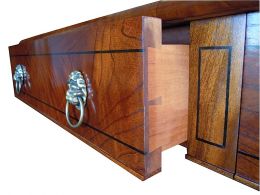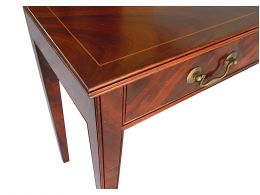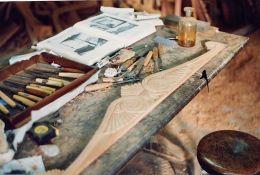HISTORY OF CABINETMAKING IN NSW
The history of cabinetmaking in the early days of the colony is bound up with Red Cedar more than any other tree. The abundance of the timber and the huge size of the boards obtained from it meant that early colonial cabinetmakers did not have the supply problems of their English counterparts who were reliant on timbers imported from South America and the West Indies. Importation was an expensive process, so to make the timber go further, the English makers were forced to cut the timber into veneers. These veneers were laid onto cheaper base timbers such as Scandinavian pine. Veneers have always been subject to separation from the base timber due to deterioration of the animal glue used to hold them. In Australia, early makers did not have this problem and veneering, such as cross banding, was used mainly as a decorative secondary feature. Additionally, being cedar on cedar, the likelihood of separation due to different expansion rates of the two timbers, was reduced. The use of solid wood is one of the great qualities of the Golden Period of Australian furniture and contributes greatly to its quality and longevity.
A lot of Cedar was sent to Tasmania where indigenous woods were used in conjunction with it. This, together with the quality of Tasmanian craftsmanship, gives Early Tasmanian furniture a recognizable and idiosyncratic appearance unique to that state. Often, the details are finer and the methods of construction more sophisticated. Separation from the mainland cannot alone be responsible for the difference, but whatever the reasons, this furniture is particularly collectable. Curiously, in another hemisphere, this very same dichotomy existed between England and Ireland. Irish furniture is similarly quirky.
The sources for Early Australian furniture were designs from pattern books and treatises on furniture published in England at the time. Most of these were concerned with the Georgian and Regency designs that were fashionable. Amongst these, the names of Sheraton, Hepplewhite, Smith, Smee, Ackermann, Hope, Loudon and Nicholson are important along with many others. We know that these books were brought to NSW by people of considerable influence. These books, along with remembered designs, the arrival of experienced cabinetmakers from England and imported English furniture, formed the main influences for early Australian makers.
A lot of furniture of the early period is not signed or dated, particularly that which came from rural and isolated areas where everyone knew who the local maker was. In Sydney however, a more competitive climate existed and important early makers such as Joseph Sly and Andrew Lenehan used signatures, stamps and paper labels to distinguish their work.
In the big cities of England, specialisation of the trades meant that there were chair makers, case makers, turners, carvers, polishers and even people who did nothing more than make knobs. This meant that a high degree of competence, uniformity and sophistication existed in these large centres whereas in isolated areas, the provincial system operated. This meant that pieces often had a more quirky or rustic appearance because all the work had to be done by one man who might not have been trained in specialist areas such as carving. The result however, was the production of pieces that had a ‘signature’ look identifying them as the work of a particular man even though they were not signed. Ironically, while challenged by their shortcomings, they often triumphed over them, producing pieces of great execution and visual distinction which are now highly prized by collectors.
It is this provincial system where one man does everything that Peter Gibbs has tried to save from extinction using it as a template for his labours. He feels that this is where the historic heart of furniture making in Australian Red Cedar is to be found.


